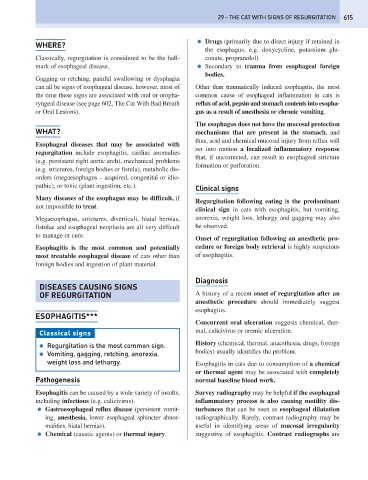Page 623 - Problem-Based Feline Medicine
P. 623
29 – THE CAT WITH SIGNS OF REGURGITATION 615
● Drugs (primarily due to direct injury if retained in
WHERE?
the esophagus, e.g. doxycycline, potassium glu-
Classically, regurgitation is considered to be the hall- conate, propranolol).
mark of esophageal disease. ● Secondary to trauma from esophageal foreign
bodies.
Gagging or retching, painful swallowing or dysphagia
can all be signs of esophageal disease, however, most of Other than traumatically induced esophagitis, the most
the time these signs are associated with oral or oropha- common cause of esophageal inflammation in cats is
ryngeal disease (see page 602, The Cat With Bad Breath reflux of acid, pepsin and stomach contents into esopha-
or Oral Lesions). gus as a result of anesthesia or chronic vomiting.
The esophagus does not have the mucosal protection
WHAT? mechanisms that are present in the stomach, and
thus, acid and chemical mucosal injury from reflux will
Esophageal diseases that may be associated with
set into motion a localized inflammatory response
regurgitation include esophagitis, cardiac anomalies
that, if uncorrected, can result in esophageal stricture
(e.g. persistent right aortic arch), mechanical problems
formation or perforation.
(e.g. strictures, foreign bodies or fistula), metabolic dis-
orders (megaesophagus – acquired, congenital or idio-
pathic), or toxic (plant ingestion, etc.). Clinical signs
Many diseases of the esophagus may be difficult, if
Regurgitation following eating is the predominant
not impossible to treat.
clinical sign in cats with esophagitis, but vomiting,
Megaesophagus, strictures, diverticuli, hiatal hernias, anorexia, weight loss, lethargy and gagging may also
fistulae and esophageal neoplasia are all very difficult be observed.
to manage or cure.
Onset of regurgitation following an anesthetic pro-
Esophagitis is the most common and potentially cedure or foreign body retrieval is highly suspicious
most treatable esophageal disease of cats other than of esophagitis.
foreign bodies and ingestion of plant material.
Diagnosis
DISEASES CAUSING SIGNS
OF REGURGITATION A history of a recent onset of regurgitation after an
anesthetic procedure should immediately suggest
esophagitis.
ESOPHAGITIS***
Concurrent oral ulceration suggests chemical, ther-
Classical signs mal, calicivirus or uremic ulceration.
● Regurgitation is the most common sign. History (chemical, thermal, anaesthesia, drugs, foreign
● Vomiting, gagging, retching, anorexia, bodies) usually identifies the problem.
weight loss and lethargy. Esophagitis in cats due to consumption of a chemical
or thermal agent may be associated with completely
Pathogenesis normal baseline blood work.
Esophagitis can be caused by a wide variety of insults, Survey radiography may be helpful if the esophageal
including infectious (e.g. calicivirus). inflammatory process is also causing motility dis-
● Gastroesophageal reflux disease (persistent vomit- turbances that can be seen as esophageal dilatation
ing, anesthesia, lower esophageal sphincter abnor- radiographically. Rarely, contrast radiography may be
malities, hiatal hernias). useful in identifying areas of mucosal irregularity
● Chemical (caustic agents) or thermal injury. suggestive of esophagitis. Contrast radiographs are

